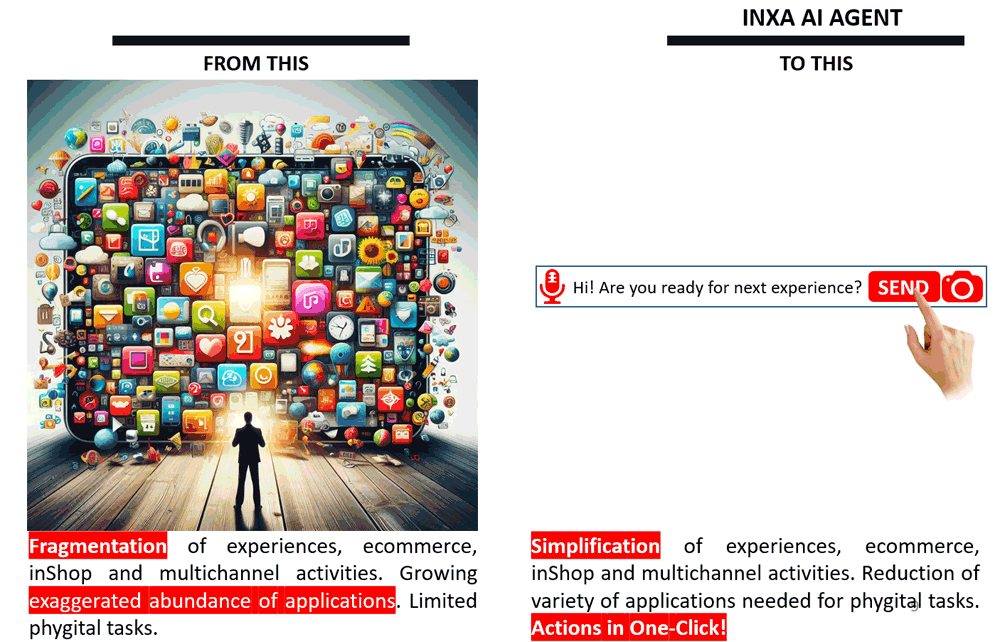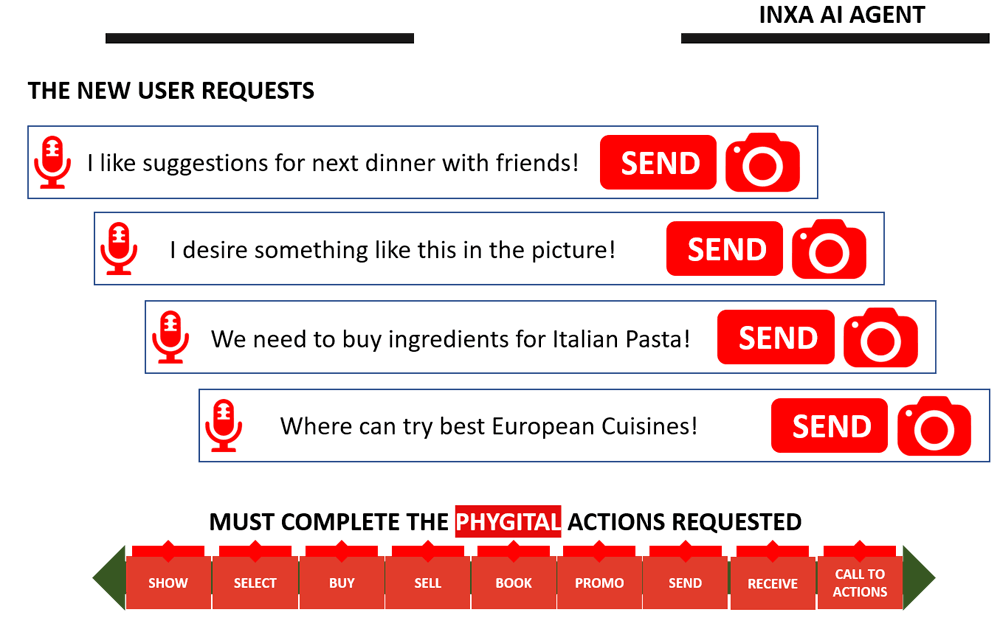INXA AI Agents: Difference between revisions
| Line 1: | Line 1: | ||
== INXA AI Agents == | == INXA AI Agents == | ||
'''[https://inxa.one INXA AI Agents]''' are intelligent virtual assistants integrated into the Nexth Experiential Phygital All-in-One XClub platform. These AI Agents are designed to enhance user interactions by providing real-time support, personalized recommendations, and insights, making the platform more intuitive and user-friendly. | '''[https://inxa.one INXA AI Agents]''' are '''intelligent virtual assistants integrated into the Nexth Experiential Phygital All-in-One XClub platform.''' These AI Agents are designed to enhance user interactions by providing real-time support, personalized recommendations, and insights, making the platform more intuitive and user-friendly. | ||
<embed width="100%">https://inxa.one/wetubesfast.php?product=5485dea688833923671172221c1ecbb3&wetubesid=Inxa-All-In-One&vnav=nexthitv&posterid=nexthitv&back=nexth&videopos=0&videoadd=0&roll=1&nochat=1</embed> | <embed width="100%">https://inxa.one/wetubesfast.php?product=5485dea688833923671172221c1ecbb3&wetubesid=Inxa-All-In-One&vnav=nexthitv&posterid=nexthitv&back=nexth&videopos=0&videoadd=0&roll=1&nochat=1</embed> | ||
Revision as of 17:03, 3 July 2024
INXA AI Agents
INXA AI Agents are intelligent virtual assistants integrated into the Nexth Experiential Phygital All-in-One XClub platform. These AI Agents are designed to enhance user interactions by providing real-time support, personalized recommendations, and insights, making the platform more intuitive and user-friendly.
Overview
INXA AI Agents leverage advanced artificial intelligence technologies to understand and respond to user needs effectively. They play a crucial role in the Nexth.one ecosystem by facilitating seamless interactions between users and the platform's various features.
From Fragmentation to Semplification

Fragmentation of Experiences in E-commerce and Multichannel Activities
The Challenge of Fragmentation
In today's digital age, consumers are inundated with a vast array of e-commerce platforms, applications, and shopping experiences. This phenomenon, known as the fragmentation of experiences, poses significant challenges for both businesses and consumers. The proliferation of countless apps and channels has led to an exaggerated abundance of options, often overwhelming users and diluting brand engagement.
E-commerce and InShop Integration
As e-commerce continues to grow, the integration of online and in-store (InShop) experiences becomes crucial. However, the seamless blending of these channels is often hampered by the sheer number of applications and platforms. Consumers expect a unified experience, whether they are shopping online or in-store, but the reality is often a fragmented journey. This disjointed approach can lead to confusion, reduced customer satisfaction, and ultimately, lower sales.
Multichannel Activities
Businesses today are leveraging multiple channels to reach their customers, including websites, mobile apps, social media, and physical stores. While multichannel strategies aim to enhance customer engagement and convenience, the excessive abundance of platforms can create inconsistencies in the user experience. Customers might encounter different pricing, availability, and promotions across channels, leading to frustration and mistrust.
The Problem with Exaggerated Abundance
The proliferation of e-commerce applications and platforms has led to an exaggerated abundance that overwhelms consumers. With so many options, users struggle to find and stick with the platforms that best meet their needs. This abundance can also dilute brand loyalty, as consumers might switch between different platforms based on convenience or specific offerings, rather than maintaining a consistent relationship with one brand.
Limited Phygital Tasks
While the integration of physical and digital (phygital) tasks holds promise for creating seamless shopping experiences, its implementation remains limited. Phygital initiatives, such as click-and-collect services, in-store digital kiosks, and augmented reality shopping, are often sporadic and inconsistent. This limited adoption prevents businesses from fully capitalizing on the potential of merging physical and digital experiences to enhance customer engagement and satisfaction.
Addressing Fragmentation
To combat the challenges of fragmented experiences, businesses must prioritize creating cohesive and unified customer journeys across all touchpoints. This involves:
- Streamlining Platforms: Reducing the number of separate applications and integrating functionalities into a single, comprehensive platform can simplify the user experience.
- Consistency Across Channels: Ensuring that pricing, promotions, and product availability are consistent across all channels to build trust and reliability.
- Enhancing Phygital Integration: Expanding and improving phygital initiatives to create more seamless interactions between online and offline experiences.
- Personalization: Leveraging data and AI to personalize the shopping experience, guiding consumers through the plethora of options to find what best suits their needs.
By addressing these challenges, businesses can better navigate the complexities of the modern e-commerce landscape, providing consumers with a more streamlined, satisfying, and cohesive shopping experience.
Simplification of Experiences in E-commerce and Multichannel Activities
In the rapidly evolving digital marketplace, consumers are often overwhelmed by the sheer number of applications and platforms they need to navigate for a seamless shopping experience. This fragmentation not only complicates the user journey but also poses significant challenges for businesses striving to maintain consistent engagement and satisfaction.
Simplification of Experiences
The key to enhancing customer satisfaction lies in the simplification of experiences across e-commerce, inShop, and multichannel activities. By streamlining these processes, businesses can create a more intuitive and cohesive experience that meets consumer expectations.
- Unified User Journey: Simplifying the user journey across various platforms ensures that consumers can transition smoothly between online and offline experiences without facing inconsistencies or disruptions.
- Integrated Solutions: Offering integrated solutions that consolidate different functionalities into a single platform can drastically reduce the complexity of managing multiple applications.
Reduction of Applications for Phygital Tasks
Phygital tasks, which blend physical and digital interactions, are becoming increasingly important in the modern shopping landscape. However, the variety of applications required to manage these tasks can be overwhelming.
- Consolidation of Tools: By reducing the number of applications needed for phygital tasks, businesses can streamline operations and enhance user experiences. A consolidated platform can manage everything from online purchases to in-store pickups, providing a seamless experience for consumers.
- Efficiency and Ease of Use: Fewer applications mean less time spent learning and managing different systems, leading to greater efficiency and ease of use for both customers and staff.
Actions in One-Click!
In today's fast-paced world, convenience is king. The ability to perform actions with a single click can significantly enhance user satisfaction and operational efficiency.
- One-Click Solutions: Implementing one-click solutions for common tasks, such as purchasing, booking, or customer support, can greatly simplify the user experience. This not only reduces friction in the customer journey but also speeds up transaction processes.
- Improved Engagement: One-click actions can lead to higher engagement rates as they reduce the effort required from users, making them more likely to complete desired actions.
By focusing on the simplification of experiences, reducing the variety of applications needed for phygital tasks, and offering one-click solutions, businesses can significantly enhance their e-commerce and multichannel activities. These improvements lead to a more streamlined, efficient, and satisfying experience for consumers, ultimately driving better engagement and loyalty.
The New User Interface
The new interface in the AI generative era is a game-changer, not just about visual changes; These interfaces are not just digital; they are 'phygital’, combining physical and digital elements to create a seamless user experience.
Instead of traditional graphical user interfaces (GUIs), we are moving towards more intuitive, wearable and natural interfaces. These include voice-based interfaces, gesture-based interfaces, and even brain-computer interfaces.

Conversational Interface and Personalized Interactions
The Evolution of Conversational AI
With advancements in natural language processing (NLP), conversational AI interfaces have undergone significant transformation, becoming more natural and context-aware. These interfaces now possess the ability to understand and respond to human language in a way that feels intuitive and engaging. As a result, they are increasingly being integrated into various digital platforms, enhancing user interaction and satisfaction.
Natural and Context-Aware Interactions
The integration of advanced NLP allows conversational AI to not only comprehend user input but also to interpret the context behind it. This means that these AI systems can maintain coherent conversations, understanding nuances and subtleties in human speech. Whether it's a virtual assistant, a customer service chatbot, or an interactive voice response system, these AI-driven interfaces offer a more human-like interaction experience.
AI-Driven Personalization
Personalization is at the forefront of modern digital experiences. AI-driven personalization engines leverage generative models to tailor content to individual preferences and behaviors. By analyzing vast amounts of data, these systems can predict what users are likely to find relevant and engaging. This goes beyond mere recommendations; it includes curating entire user experiences based on individual habits and preferences.
Tailored Experiences
From personalized product recommendations to curated news feeds, conversational AI interfaces provide tailored experiences that resonate with users on a deeper level. For example:
- E-commerce: Personalized product suggestions based on past purchases, browsing history, and individual preferences enhance the shopping experience.
- Media and Entertainment: Curated content recommendations ensure users find the most relevant movies, music, or articles, enhancing user engagement and satisfaction.
- Customer Service: Context-aware chatbots can provide personalized support, addressing user queries with relevant and timely information.
Impact on User Engagement
These personalized interactions not only improve user satisfaction but also drive engagement. When users feel that their needs and preferences are understood and catered to, they are more likely to interact with the platform frequently. This increased engagement can lead to higher conversion rates, customer loyalty, and overall user retention.
Future of Conversational Interfaces
As NLP and AI technologies continue to evolve, we can expect conversational interfaces to become even more sophisticated. Future advancements might include:
- Enhanced Emotional Intelligence: AI systems that can detect and respond to human emotions, providing even more personalized and empathetic interactions.
- Multimodal Interactions: Combining voice, text, and visual inputs to create richer, more immersive conversational experiences.
- Seamless Integration: More seamless integration of conversational AI across various devices and platforms, providing a consistent user experience.
Conversational interfaces and personalized interactions represent the next frontier in user engagement. By leveraging advancements in NLP and AI-driven personalization, businesses can create more natural, context-aware, and tailored experiences that deeply resonate with users. This not only enhances user satisfaction but also drives greater engagement and loyalty, positioning businesses to thrive in the digital age.
The New User Requests Must Complete the Phygital Actions Requested
In the modern retail landscape, where digital and physical experiences are increasingly intertwined, new user requests must effectively address and complete the phygital actions required. Phygital, a blend of physical and digital, represents the seamless integration of online and offline interactions to create a cohesive and enhanced user experience.

Understanding Phygital Actions
Phygital actions encompass a variety of tasks that bridge the gap between the digital and physical worlds. These include:
- Click-and-Collect Services: Allowing users to order online and pick up in-store.
- In-Store Digital Kiosks: Providing digital assistance within physical store locations.
- Augmented Reality (AR) Experiences: Enabling users to visualize products in their real-world environment via their smartphones or AR devices.
- Integrated Customer Support: Combining online chat support with in-store assistance for a consistent customer service experience.
Meeting User Expectations
Today's users demand seamless and efficient phygital interactions. For businesses, this means creating an infrastructure that can handle these requests smoothly and effectively. Here are key strategies to ensure new user requests meet and complete the phygital actions expected:
- Unified Systems: Integrate online and offline systems to ensure real-time synchronization of inventory, customer data, and order processing. This minimizes discrepancies and enhances the user experience.
- User-Friendly Interfaces: Design intuitive and easy-to-navigate interfaces for both digital and physical touchpoints. This ensures users can complete phygital tasks with minimal friction.
- Personalized Experiences: Leverage data analytics and AI to personalize phygital interactions. Tailored recommendations, personalized support, and context-aware services can significantly enhance user satisfaction.
- Robust Support Systems: Establish comprehensive support channels that can assist users in both digital and physical environments. This includes training staff to handle phygital queries and providing robust online help resources.
- Continuous Improvement: Regularly gather user feedback and analyze phygital action data to identify areas for improvement. This ongoing refinement ensures that user requests are consistently met with high-quality phygital solutions.
The Impact of Effective Phygital Actions
Successfully completing phygital actions as requested by new users can lead to numerous benefits for businesses:
- Increased Customer Satisfaction: Seamless phygital experiences enhance overall satisfaction, fostering loyalty and repeat business.
- Higher Conversion Rates: Smooth transitions between online and offline channels can reduce drop-offs and increase conversion rates.
- Enhanced Brand Perception: Effective phygital strategies can position a brand as innovative and customer-centric, improving market reputation.
- Operational Efficiency: Integrated systems and streamlined processes reduce operational complexities, leading to cost savings and better resource allocation.
In a world where digital and physical experiences are increasingly interconnected, it is crucial for businesses to ensure that new user requests are equipped to handle and complete phygital actions. By focusing on unified systems, user-friendly interfaces, personalized experiences, robust support, and continuous improvement, companies can meet these demands effectively. This not only enhances customer satisfaction and loyalty but also drives business success in the evolving retail landscape.
Key Features
Real-Time Support
INXA AI Agents provide immediate assistance to users, helping them navigate the platform and find the information or services they need. This real-time support ensures that users have a smooth and efficient experience.
Personalized Recommendations
Using data analysis and machine learning algorithms, INXA AI Agents offer personalized recommendations tailored to each user's preferences and behaviors. This level of personalization enhances user satisfaction and engagement.
Intelligent Insights
INXA AI Agents generate valuable insights based on user interactions and data. These insights help businesses understand user behavior, optimize their offerings, and make informed decisions to improve the overall experience.
Benefits
Enhanced User Experience
The integration of INXA AI Agents into the Nexth.one platform significantly enhances the user experience by providing timely support and personalized interactions. This leads to higher user satisfaction and loyalty.
Increased Efficiency
By automating routine tasks and providing quick responses, INXA AI Agents increase the efficiency of the platform. Users can accomplish their goals faster, and businesses can streamline their operations.
Data-Driven Decisions
The insights generated by INXA AI Agents enable businesses to make data-driven decisions. This helps in identifying trends, optimizing services, and improving user engagement.
Applications
INXA AI Agents can be utilized in various applications across different industries, including:
- Retail: Assisting customers with product information, personalized shopping recommendations, and support.
- Entertainment: Enhancing user experiences with personalized content suggestions and interactive features.
- Education: Providing students with personalized learning resources and support.
- Healthcare: Offering patients virtual assistance, appointment scheduling, and personalized health recommendations.
All-in-One Phygital Ecosystem Management
INXA AI Agents are integrate to the management of Nexth.one’s All-in-One Phygital Ecosystem. This ecosystem combines physical and digital elements to create a cohesive and immersive experience, managed effectively through the intelligent capabilities of INXA AI Agents. Key aspects of ecosystem management include:
- Seamless Integration: Ensuring smooth interaction between various components of the ecosystem, both physical and digital.
- Dynamic Adaptation: Continuously adapting to user needs and preferences to maintain high levels of engagement and satisfaction.
- Operational Efficiency: Streamlining operations and processes within the ecosystem to deliver a seamless user experience.
- Comprehensive Analytics: Utilizing data from user interactions to generate insights and optimize ecosystem performance.
Conclusion
INXA AI Agents are a vital component of the Nexth Experiential Phygital All-in-One XClub platform, bringing advanced AI capabilities to enhance user interactions and provide valuable insights. By leveraging these intelligent agents, businesses can offer more personalized, efficient, and engaging experiences to their users. Additionally, INXA AI Agents play a crucial role in managing the All-in-One Phygital Ecosystem, ensuring seamless integration and operation of its diverse components.
For more information, visit Nexth.one.
